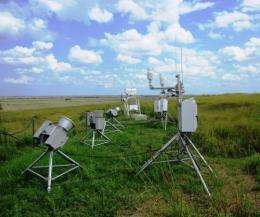Clouds' effect on sunlight energy at Earth's surface depends on the wavelength of light

Bouncing around from cloud to cloud, and down to Earth, sunlight's warmth is both enhanced and blocked by clouds. Atmospheric scientists from Pacific Northwest National Laboratory found that clouds' overall effect on the amount of sunlight available to warm the earth depends on the wavelength of sunlight being measured. Their unexpected findings show that the sunlight scattered by clouds is an important component of cloud contributions to Earth's energy balance.
The influence of clouds on both warming and cooling the earth is one of the least understood aspects of climate change. This research will provide atmospheric scientists with new information to improve how they portray clouds in climate models. Knowing how clouds contribute to the earth's energy balance will enhance our ability to accurately model and predict climate change.
Clouds both cool and warm the earth's surface. They cool the earth by bouncing sunlight back into the atmosphere; they warm it by bouncing light down to Earth's surface. The net cloud effect is what scientists need to obtain. To do that, they measured the total amount of sunlight in a cloudy day. Then, they determined the amount of energy contained in the sunlight in a cloudless, blue sky. The difference was the net cloud effect. To find out if the individual colors of light contribute to the net cloud effect, the research team measured brightness with a spectral radiometer from DOE's Atmospheric Radiation Measurement Climate Research Facility in Oklahoma. The team found that the net cloud effect changed depending on the measured visible-spectrum wavelength, and whether the sunlight was direct or scattered. Their results also suggest that aerosols, those tiny bits of dust or pollution in clouds and the sky, are responsible for the wavelength differences. Thus, clouds alone are not responsible for the different wavelengths contribution to the net cloud effect.
Scientists will use developed long- and short-term data sets from several sites around the world, along with the approach suggested by this research, to estimate the wavelength changes of the total cloud impact to improve information on the radiative properties of aerosols and clouds in large-scale climate models.
More information: Kassianov EI, et al. "Shortwave spectral radiative forcing of cumulus clouds from surface observations," Geophysical Research Letters, Vol. 38, L07801, 5 pp., 2011, doi:10.1029/2010GL046282.
Provided by Pacific Northwest National Laboratory


















